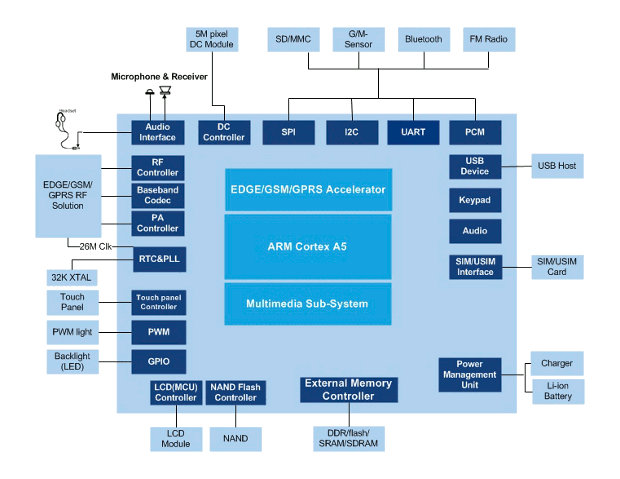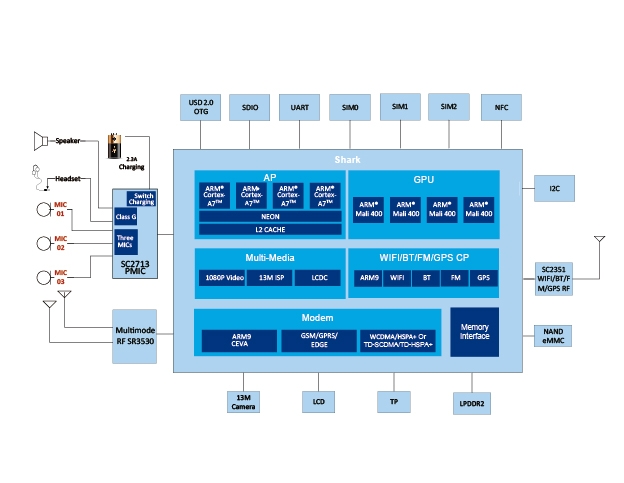The International ARM Race: Rise Of The Chinese SoC
Thanks to low prices and a gradual increase in both quality and performance, Chinese chip makers are starting to pose serious problems for Qualcomm, Nvidia and others.
Spreadtrum
Spreadtrum Communications Inc. is a Shanghai-based fabless chip maker and the world's 17th largest semiconductor company. It is best known for making chipsets for the Chinese TD-SCDMA 3G network, but it also sells chips to customers from other countries. The company was acquired last year by Tsinghua Unigroup, a Chinese consumer electronics firm.
Back in 2011, Spreadtrum managed to win 25 percent of the 2G phone market in China, mainly from MediaTek, which introduced a weaker chip at the time and, in turn, gave Spreadtrum the opportunity to grow its market share rapidly.
Today, Spreadtrum is known mainly for making chipsets that work on China’s TD-SCDMA 3G network, which covers 50 percent of the customers there. But it's also making chips for other customers in other countries. If you’re looking at the overall Chinese smartphone market, Spreadtrum only has 11 percent share.
SC6821
While we generally think of companies like MediaTek as offering entry-level hardware, Spreadtrum goes even lower. Earlier this year, we learned that Spreadtrum and Mozilla are partnering to offer a $25 Firefox OS smartphone, which is way below the retail price of any phone we've tested on Tom’s Hardware.
This smartphone will come with a SC6821 chip. We don’t know too much about the platform, other than that it's based on ARM's Cortex-A5, has support for Wi-Fi (presumably 802.11b/g/n) and Bluetooth, and integrates FM radio functionality. It also supports a camera (most likely up to 5 MP) and HVGA resolutions, will run Firefox OS, and will work on WCDMA and EDGE networks.
Mozilla most likely chose Spreadtrum due to its processor's low price. Therefore, performance and features probably weren’t the priority. At least Mozilla picked an ARMv7-capable chip, as it prepares to completely drop ARMv6 support from both Firefox OS and the mobile Firefox app for Android. The sooner everyone gets rid of ARMv6, the sooner developers can focus on supporting ARMv7 and ARMv8 architectures.
SC7735S
Mozilla is not the only big-name customer serviced by Spreadtrum. HTC has also put the Spreadtrum Quak (SC7735S) chip inside its Desire 700 mid-range smartphone. This chip is based on a quad-core Cortex-A7 1.2 GHz CPU and Mali-400 GPU. It supports up to 2 GB of RAM, 1080p video playback at 30 FPS, VP8 hardware decoding, and up to 13 MP cameras.
Get Tom's Hardware's best news and in-depth reviews, straight to your inbox.
HTC hasn't had the best luck with its low-end smartphone offerings because, for some reason, it always ends up more expensive than the competition sporting similar specs. Spreadtrum might help HTC reduce its overall prices for its low-end smartphones.
Earlier this year, there were some talks about a potential Spreadtrum/RDA Microelectronics merger, but this deal was met with opposition from RDA employees, who consider Spreadtrum a much less nimble company than their own.
Lucian Armasu is a Contributing Writer for Tom's Hardware US. He covers software news and the issues surrounding privacy and security.
-
jossrik It'll be interesting to see where manufacturing goes in the future, maybe back to EU or even Africa somewhere maybe. Right now it's hard to see things get cheaper than China, but of course, eventually it will happen. I hear Apple is gonna buy China.Reply -
Draven35 ReplyThe company's first commercial foray using this technology came in 1983 with the 16-bit Acorn RISC Machine, or ARM. It ran one of the first true multitasking operating systems in production, RISC OS,
Except, the first silicon didn't exist until 1985, and the machine running RISC OS didn't exist until 1987. -
blubbey ReplyGod bless, America. If you can't beat them, join them!
ARM are British though..... (unless I'm missing something which is entirely possible). -
virtualban The Chinese may leech off and profit from current available designs, and close-source their 'innovations', but I wonder what will they do when the rest of the world will reverse engineer and use any progress they make without having to answer to the Chinese companies (duh).Reply -
icemunk The writer seems to think the RK3288 is a 2015 SOC, however it has been out since April, and many devices are available with it, lots of $200 tablets with 2000X1500 resolution, and a bunch of TV boxes as well for $100. It's an excellent chip, achieving around 40,000 antutu scores. 2015 I'm sure we'll see a brand-new Rockchip, but the RK3288 has been out for some time.Reply -
Reply
MediaTek is Taiwanese not Chinese
remove it from the list
Since when is Taiwanese not Chinese? Read a book. -
oxiide Reply
Hopefully your books mention that the Republic of China (Taiwan) and the People's Republic of China (mainland China) are two distinct and, for the most part, recognized nations.MediaTek is Taiwanese not Chinese
remove it from the list
Since when is Taiwanese not Chinese? Read a book.
MediaTek is indeed a Taiwanese company, though I'd rather they just specify that in the article rather than being told to remove it over a technicality. It's still relevant to the topic regardless of where they are headquartered. -
amk-aka-Phantom Thanks to the author for pointing out the closed-source BS, this makes me hate Mediatek. Others are irrelevant (luckily) so far, don't see their chips in any reasonable devices.Reply

